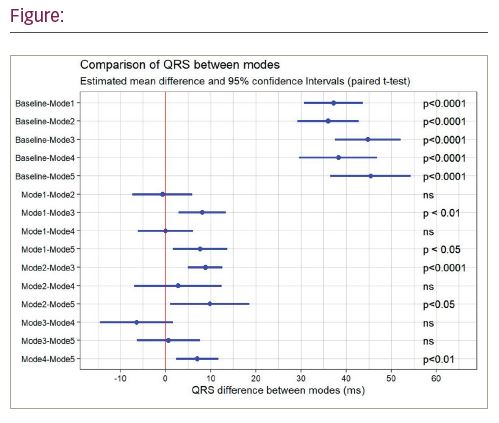Introduction: Not all patients respond favourably to CRT. Electrical programming may improve CRT response, but a universal programming strategy may be ineffective as patient specific factors can influence electrical timing within the heart. Moreover, there is little guidance for CRT programming, hence CRT devices are often left at suboptimal settings.1 Two emerging technologies, fusion pacing (e.g SyncAV) and multipoint pacing (MPP), have been shown to narrow QRS and give acute benefit. It seems intuitive that combining technologies may augment the benefit but there is little evidence available to support this. This study compared five programming strategies to determine which produced the narrowest QRS.
Methods: This was an observational study of current clinical practice at a single study centre. 27 patients (with intact AV conduction) were implanted with an Abbott CRT for standard CRT indications. Baseline QRS duration was measured on the operating table. Immediately following CRT implantation, five different programming strategies were temporarily applied aiming for narrowest QRS:
- Mode 1. Best single point BiV pacing using QuickOpt
- Mode 2. Best single point BiV pacing with nominal SyncAV
- Mode 3. Best single point BiV pacing with individualised SyncAV
- Mode 4. BiV pacing using QuickOpt and MPP
- Mode 5. BiV pacing with MPP and individualised SyncAV
In each case, abbreviated global QRS duration (QRSd) was measured on the device programmer using digital calipers in leads I, II, III, aVF and V5 and 50 mm/sec sweep speed. QRSd was verified by a second independent operator.
Results: Data were collected on 27 patients until suspension of enrolment in March 2020 due to COVID-19. Several significant differences were identified, as shown in the graph below. As expected, all paced modes achieved highly significant reductions in QRSd (p<0.0001) compared to baseline. The largest mean reductions in QRSd compared to baseline were obtained with Mode 3 (individualised SyncAV) and Mode 5 (MPP and individualised SyncAV). Mode 3 showed reduction in QRSd when compared to Mode 1 (p<0.01) and Mode 2 (p<0.0001). Mode 5 also showed significant reduction in QRSd when compared to Modes 1 (p<0.05), 2 (p<0.05) and 4 (p<0.01).
Discussion: This study supports the view that individualised CRT programming (Mode 3 and 5) can produce maximal QRS narrowing. These were the only two programming strategies to show significant superiority over best single point BiV pacing (Mode 1). The combination of MPP with individualised SyncAV (Mode 5) was associated with some of the best individual improvements. Clinically, MPP is not suitable for all patients due twitch or myocardial viability, and in this situation, individualised SyncAV (Mode 3) is equally effective in selected patients. From this data, individualised SyncAV appears more influential than MPP, in reducing QRSd but further research is needed in this area.

References
- 1. Varma N, O’Donnell D, Bassiouny M, et al. Programming cardiac resynchronization therapy for electrical synchrony: Reaching beyond left bundle branch block and left ventricular activation delay. J Am Heart Assoc. 2018;7:e007489







